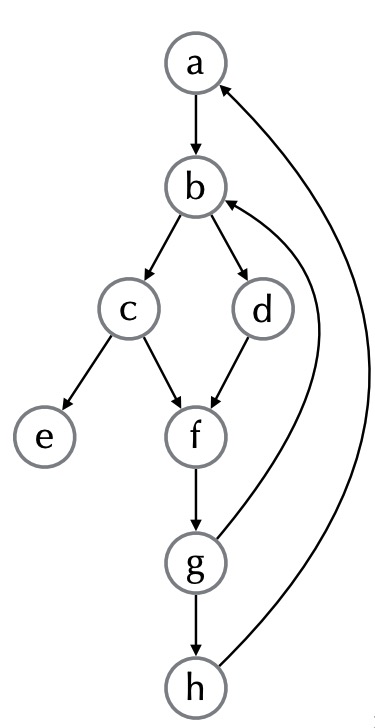Before optimizing a loop, we need to first define a loop in the control flow graph. Note that each node in a control flow graph is a basic block.
Identifying loops
Cycles in the control flow graph are not necessary loops. A loop is a subset S of nodes where:
- S is strongly connected. In other words, for any two nodes in S, there is a path from one to the other using only nodes in S
- There is a distinguished header node
h∈Ssuch that there is no edge from a node outside S toS\{h}
Dominators
Node d dominates node n in a graph (d dom n) if every path from the start node to n goes through d
Dominators can be organized as a tree
- a -> b in the dominator tree iff a immediately dominates b
Back edge
Back edge is an edge from n to dominator d.
Example
In the above example, we have:
- a dominates a,b,c,d,e,f,g,h
- b dominates b,c,d,e,f,g,h
- c dominates c,e
- d dominates d
- e dominates e
- f dominates f,g,h
- g dominates g,h
- h dominates h
- back-edges: g→b, h→a
Natural Loops
The natural loop of a back edge is the smallest set of nodes that includes the head and tail of the back edge, and has no predecessors outside the set, except for the predecessors of the header.
- Single entry-point: header that dominates all nodes in the loop
Algorithm to Find Natural Loops:
- Find the dominator relations in a flow graph
- Identify the back edges
- Find the natural loop associated with the back edge
Loop fusion & loop fission
Both loop fusion and loop fisson make good uses of the reference locality property. Loop fusion combines two loops into one while loop fission seperates one loop into two.
Loop fusion
1
2
3
4
5
6
7
8
9
10
11
12
13
14
15
16
17
// before fusion
int sum = 0;
for (int i = 0; i < n; ++i) {
sum += a[i];
a[i] = sum;
}
for (int i = 0; i < n; ++i) {
b[i] += a[i];
}
// after fusion
int sum = 0;
for (int i = 0; i < n; ++i) {
sum += a[i];
a[i] = sum;
b[i] += a[i];
}
Loop fission
1
2
3
4
5
6
7
8
9
10
11
12
13
14
// before fission
for (int i = 0; i < N; ++i) {
a[i] = e1;
b[i] = e2;
}
// after fission
for (int i = 0; i < N; ++i) {
a[i] = e1;
}
for (int i = 0; i < N; ++i) {
b[i] = e2;
}
Loop unrolling
Loop unrolling re-writes the loop body and each iteration of rewritten loop will perform several iterations of old loop.
1
2
3
4
5
6
7
8
9
10
11
// before unrolling
for (int i = 0; i < n; ++i) {
a[i] = b[i] * 7 + c[i] / 13;
}
// after unrolling
for (int i = 0; i < n; i+=3) {
a[i] = b[i] * 7 + c[i] / 13;
a[i + 1] = b[i + 1] * 7 + c[i + 1] / 13;
a[i + 2] = b[i + 2] * 7 + c[i + 2] / 13;
}
The benefit of loop unrolling is reducing branching penalty & end-of-loop-test costs.
Loop tiling
Loop tiling partitions a loop’s iteration space into smaller chunks or blocks, so as to help ensure data used in a loop stays in the cache until it is reused.
1
2
3
4
5
6
7
8
9
10
11
12
13
14
15
16
17
18
19
20
// before tiling
for (i = 0; i < n; i++) {
c[i] = 0;
for (j = 0; j < n; j++) {
c[i] = c[i] + a[i][j] * b[j];
}
}
// after tiling
for (i = 0; i < n; i += 4) {
c[i] = 0;
c[i + 1] = 0;
for (j = 0; j < n; j += 4) {
for (x = i; x < min(i + 4, n); x++) {
for (y = j; y < min(j + 4, n); y++) {
c[x] = c[x] + a[x][y] * b[y];
}
}
}
}
Loop interchage
1
2
3
4
5
6
7
8
9
10
11
12
13
// before interchage
for (int j = 0; j < n; ++j) {
for (int i = 0; i < n; ++i) {
a[i][j] += 1;
}
}
// after interchage
for (int i = 0; i < n; ++i) {
for (int j = 0; j < n; ++j) {
a[i][j] += 1;
}
}
The benefit of loop interchange is reference locality.
Loop parallelization
Strength reduction
Computation Hoisting
Reference
Wiki: Control Flow Graph
Wiki: Loop Tiling
CSC D70: Compiler Optimization LICM (Loop Invariant Code Motion)
